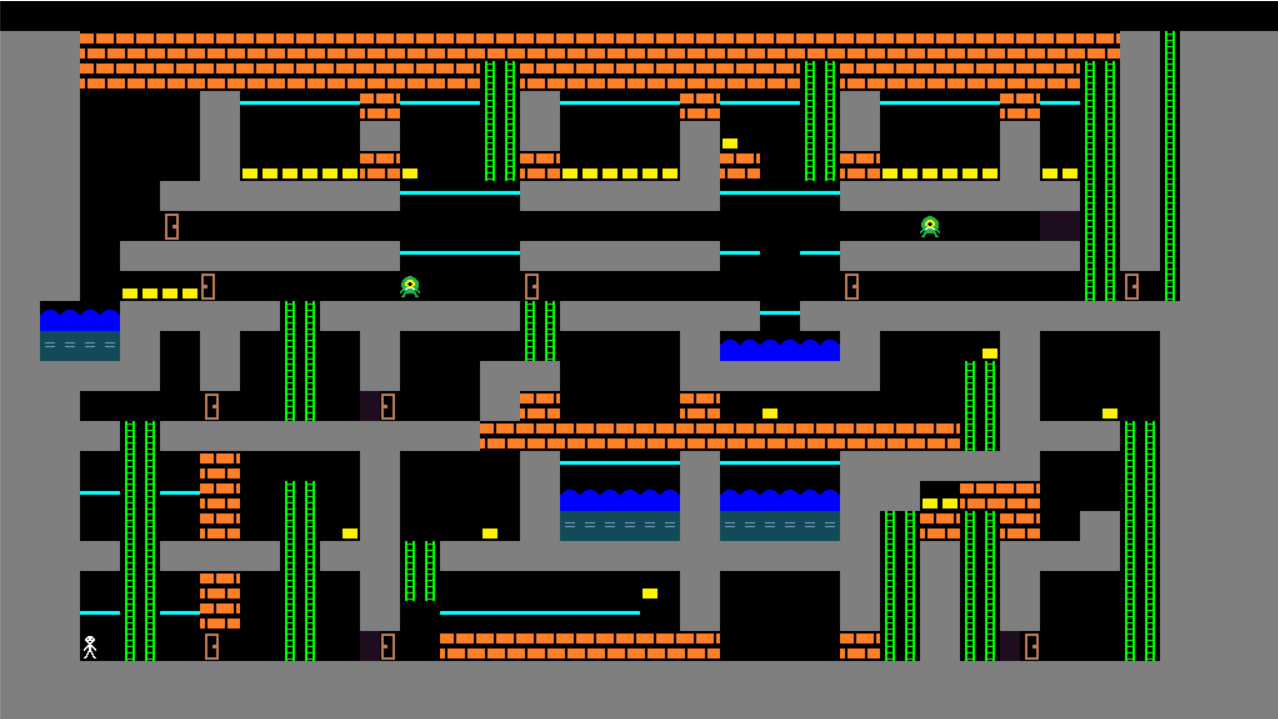This is a port of Treasure (Russian: Клад) game, which is well known on Radio-86RK soviet computer and its derivatives.
The goal if the game is to find exit of each map. The Player has to find a way through the labyrinth of blocks, doors, and ladders, and not to fall into the water. Some doors are blocked, and require a treasure box to be found first. Most of the treasure boxes are empty, and Player has to find the one with a treasure. Enemies want to catch the Player, which makes the game quite challenging.
The player can be controlled with the arrow keys. 'Q' and 'W' keys will throw an arrow, that can be used to destroy bricks and open a path. Bricks are restored over time.
The dot ('.') key can be used to abandon the current map and move to the next one.
The following blocks exist in the game:
 - Concrete, cannot be broken with arrows
- Concrete, cannot be broken with arrows - Brick, can be broken with arrow. Restores over time
- Brick, can be broken with arrow. Restores over time - Ladder. Player and enemies may go up and down through the map using ladders.
- Ladder. Player and enemies may go up and down through the map using ladders. - Water. Player dies when falls to the water. Enemies die as well, but respawn over time.
- Water. Player dies when falls to the water. Enemies die as well, but respawn over time. - Thin floor. Player and enemies can walk over the thin floor, but will fall through when falling from above
- Thin floor. Player and enemies can walk over the thin floor, but will fall through when falling from above - Treasure box. Most of the boxes are empty, but if you are lucky you can find a treasure (
- Treasure box. Most of the boxes are empty, but if you are lucky you can find a treasure ( )
) - Door. Will open when Player approaches from one side, but does not open from the other side. Some of the doors require treasure to be found first
- Door. Will open when Player approaches from one side, but does not open from the other side. Some of the doors require treasure to be found first- Other type of blocks (
 ,
,  ,
,  ,
,  ,
,  ,
,  ,
,  ) are just empty blocks, and added to the game for variety.
) are just empty blocks, and added to the game for variety.
The original Treasure game that was released in 1987. The Radio-86RK computer had B/W monitor, that could display only text characters (non graphical display). Each block was shown as a different type of symbol.
This port intentionally mimics all the features of the original game, including player and enemies movement one block at a time. Definitely, movements may be done much smoother, the graphics may be better, enemies could be smarter, but this would be another game.
I was dissassembling the original Treasure game. The author did tremendous amount of work to implement all the game cases, design the map format, and fit everything into quite poor computer resources. I am impressed how this all could be developed without a rich compiler and debugging tools we have nowadays.
While the overall code quality is ok, some of the functions could be implemented better. I spend over 20 hours trying to understand the how this code is working. I decided to challenge myself and see how fast I can develop a similar game with modern language and tools. I could do this in about 6 hours :)

